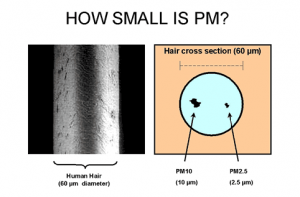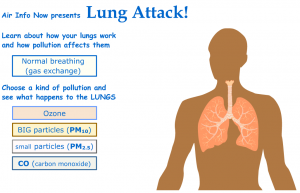Particulate Matter (PM) is a mix of solid and liquid pollutants that can be separated into the two categories depending on their size. PM2.5 are fine particles that are 2.5 micrometers in diameter; PM10 are coarse particles that are between 2.5 and 10 micrometers. Additionally, there is a category known as ultrafine particles, which are smaller than 0.1 micrometers.

PM can originate from various sources, which then determine the composition of the PM and the effects it could cause. Typically, PM is made up of nitric acids, sulfuric acids, other organic chemicals, metals, and soil/dust particles. PM10 primarily are dust and soot, which can be from vehicles on roadways and industrial areas. PM2.5 are generally from forest fire smoke and industrial combustion sources.
PM can be in the form of smoke, soot, dust, salt, acids, and metals. Additionally, PM can be from gaseous nitrogen oxides and sulfur oxides when they are released into the atmosphere (typically from burning fossil fuels) and undergo chemical reactions with the ozone to become PM. This reaction is called oxidation. Further reaction with water vapor can lead to acid rain formation.
Because they are so small, PM can be easily breathed in by people, entering the respiratory system and wreak havoc on their cardiovascular system. PM10 is large enough to get caught in mucus or cilia of the nose and throat, which will lead to coughing and expelling the particulate matter out.
PM2.5 are small enough to enter the lungs, as deep as the bronchioles (passageway from nose or mouth to the air sacs) and alveoli (air sac surrounded by artery and veins, which is where the blood cells exchange carbon dioxide for oxygen). Because PM2.5 can penetrate deeper into the lungs, the severity of the health effects increases.
Ultrafine PM can integrate into the bloodstream through the alveoli. This causes PM to spread throughout the body into organs such as the heart and brain. PM is made up of toxic pollutants. Accumulation of PM in the body can create chronic respiratory problems. For people with heart or lung diseases and exposure to PM have a higher risk of premature death and heart attacks. Overall any prolong exposure to any PM is toxic and leads to health problems. When exposed to PM, people with existing heart and lung diseases, young children, and the elderly are at high risk for health complications.
Since 1995, the National Center of Environmental Research (NCER) has been studying PM to further understand its health impacts on people and the environment. Their discoveries will help set up the PM National Ambient Air Quality Standards. Research will allow both the government and public to understand what PM is and what to do about it.

Information obtained from Environmental Protection Agency (EPA) and Clean Heat Asbruton
![]() Particulate Matter: What is it and what does it do by Kim Pearson is licensed under a Creative Commons Attribution-NoDerivatives 4.0 International License.
Particulate Matter: What is it and what does it do by Kim Pearson is licensed under a Creative Commons Attribution-NoDerivatives 4.0 International License.
Leave a Reply
You must be logged in to post a comment.